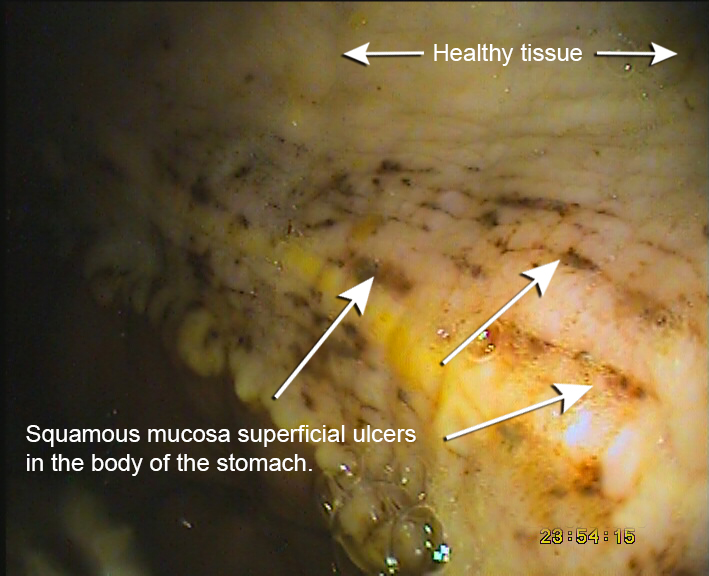Meg Miller Turpin, DVM & Diplomate American College of Veterinary Internal Medicine talks about the reasoning behind the study.
Q. Why did you decide to focus the study on gastric ulcers?
A. Gastric ulcers are a pervasive health concern in horses. They are open sores in the lining of the horse’s stomach due to prolonged exposure to normal stomach acid, among other insults. All types and ages of horses can suffer from ulcers, but it’s known that sport horses, especially race and show horses, have an 80-90% incidence or prevalence to develop ulcers.
We decided to do the study because a common benefit of Hyperbaric Oxygen Treatment (HBOT) is that it decreases swelling and inflammation, which increases circulation and allows more oxygen to reach the injured tissue and assist the healing process.
The routine treatment for ulcers is acid-suppressing medications, but I find that many horses don’t respond quickly to this treatment if they respond at all. In addition, acid is produced in the stomach for many biological processes and the chronic and even acute use of antacids can have negative side effects. For instance, a normal level of stomach acid is required to digest and absorb vitamins and minerals and is very important in the breakdown of protein. Omeprazole, the antacid in Gastrogard and Ulcergard, has been shown to delay gastric emptying and this can be a problem in some horses prone to gastric impactions.

If we could decrease the amount of time the horse needs to be on antacids or treat the horse with another medication without changing the acid status of the stomach while still allowing the stomach to heal, then the use of hyperbaric oxygen may be beneficial.
Q. Why are gastric ulcers so prevalent?
A. Multiple factors can increase the risk of ulcers in horses. Stall confinement alone can lead to the development of gastric ulcers as can high starch diets with few meals fed per day. The horse produces acid continually and any time the stomach is empty there is no food to naturally buffer the acid. In addition, extended use of non-steroidal anti-inflammatory agents (bute, banamine, equiox) and often corticosteroids can also contribute to the development of ulcers.
Stress, both environmental and physical, can increase the likelihood of ulcers, as can intense training/exercise, showing, frequent traveling or long-distance hauling.

Q. Have you used HBOT to treat ulcers?
A. I have only treated one horse in the chamber thus far with severe ulcers at the pylorus. The pylorus is the sphincter at the bottom of the stomach that allows emptying. This horse had been aggressively treated with many anti-ulcer medications for three months prior to using the hyperbaric chamber. The traditional anti-ulcer treatment in this horse for 90 days failed to show any significant healing. I treated this horse for five days in the oxygen chamber (45-minute sessions each day) and my follow-up gastroscopy revealed a healthier appearing mucosa (stomach lining) and more accelerated healing process with HBOT therapy.
Dr. Nathan Slovis, the internist and manager of the oxygen chamber at Hagyard, Davidson, McGee Medical Institute in Kentucky, reported to me that he also had a patient with chronic non-healing gastric ulcers. He decided to do a trial of three hyperbaric oxygen treatments on this horse and was amazed that the ulcers were almost cured at the end of three treatments whereas traditional medications had failed.

Q. If the results of the study show that HBOT does expediate the healing of ulcers, will HBOT be recommended as an adjunct treatment or considered a stand-alone treatment?
A. If the results of this study prove that HBOT works alone to help heal stomach ulcers, then I would use it as an adjunct treatment with other standard anti-ulcer medications, such as omeprazole, in hopes of expediting the entire healing process. The quicker we can heal the stomach ulcers, the less chance of the horse experiencing colic as a possible side effect from the ulcers.

Q. If study results prove positive, what role do you see HBOT playing in continuing maintenance, if at all?
A. If HBOT works then I do see a role as maintenance or prophylactic therapy. We know that sport horses, especially race and show horses, have a high incidence or prevalence to develop gastric ulcers. We can’t scope them monthly, but if we know there is a risk factor then perhaps 3 treatments every 4-6 weeks would be enough to help prevent gastric ulcers from becoming severe or causing life threatening colic.

